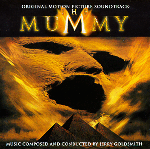 I don't share the more and more widespread opinion that the career of Jerry Goldsmith is crossing a new creative phase. This phase, apparently, highlights for the progressive abandonment of that series of rules and of ideas that it had acquired such an excessive identity that they were able to subdue the own sense of each work, until the point that among each score, almost the only evident and appreciable difference would be the orchestration. Partly, this is quite certain and ostensible for those that follows Goldsmith, although I don't believe that this presumed transition phase that would begin last year with Mulan (1998), it caracterize only for the previously exposed thing and that this is completely true. What seems certain it is that the quality of the Master's compositions is susceptible in great measure of the gender and the content of the movies in that it intervenes (something that it didn't happen in the past), fact that, by the way, it is applicable to a great percentage of the current film composers. For this reason Mulanis a sophisticated and complex score, and U.S. Marshals (1998) it is exaggeratedly poor and decadent.
I don't share the more and more widespread opinion that the career of Jerry Goldsmith is crossing a new creative phase. This phase, apparently, highlights for the progressive abandonment of that series of rules and of ideas that it had acquired such an excessive identity that they were able to subdue the own sense of each work, until the point that among each score, almost the only evident and appreciable difference would be the orchestration. Partly, this is quite certain and ostensible for those that follows Goldsmith, although I don't believe that this presumed transition phase that would begin last year with Mulan (1998), it caracterize only for the previously exposed thing and that this is completely true. What seems certain it is that the quality of the Master's compositions is susceptible in great measure of the gender and the content of the movies in that it intervenes (something that it didn't happen in the past), fact that, by the way, it is applicable to a great percentage of the current film composers. For this reason Mulanis a sophisticated and complex score, and U.S. Marshals (1998) it is exaggeratedly poor and decadent.Following this reasoning, it should not surprise anybody the remarkable quality of the score to The Mummy (1999) that show off derived (mainly in form and texture) from the previous, still unpublished, but apparently excellent The 13th Warrior (1999), recorded earlier this year with the National Philharmonic Orchestra in London (and that it will publish Varése). Almost everything in this work is fascinating, but it highlights especially Goldsmith' capacity to develop the main leitmotiv and to apply him infinite harmonic variations, being able to endow him of at least three dimensions; the leitmotiv, of four notes, works as powerful majestic theme, synthesizing the splendor of the Egypt of the Pharaohs (Imhotep ), as a love theme, of shamelessly old flavor (Giza Port , The Sand Volcano) and as dynamic theme of adventures (Camel Race), with what is able to connect and to unify the history, avoiding a possible failure that subtracts credibility to the temporary changes of the movie. At the margin of this masterful development that returns us to the Goldsmith of sixties and seventies, it is fundamental the skilled integration of the coloring and of the Egyptian instrumentation in the score, where play first roles in order the lute, the darabuka and the Nay flute –and that remit us to the delicious Justine (1966)- that grant the necessary exotic shade to one of Goldsmith's last best scores that, in spite of everything, it continues having an incomprehensible faith in the electronic element, here completely inadequate. D.R.C.


